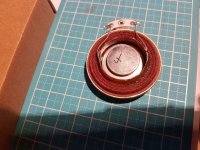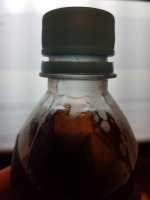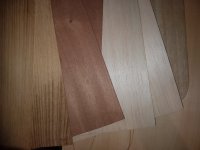Hello EricUh....yeah, kinda.
Yes, for sure, DML panels have "natural frequencies" also called "resonances frequencies" or "eigenfrequencies". In fact, those natural frequencies are the "modes" from which a Distributed Mode Loudspeaker gets it's name.
But the interesting thing about panels is that their resonance frequencies are almost never "harmonics". Harmonics are natural frequencies that are integer multiples of each other, like 100 Hz, 200 Hz, 300 Hz, etc. Indeed, tensioned strings (like on a piano) and pipes (like flutes) have a series of natural frequencies that are integer multiples of each other, and hence have "harmonics". Panels, on the other hand, exhibit a set of natural frequencies which are very irregularly spaced along the frequency spectrum, and decidedly non-harmonic (not integer multiples).
So if a panel plays harmonics when fed a pure sinusoidal tone, I think it's more accurate to say that it is "despite" being a panel, rather than "because" it's a panel.
I do wonder how many of us comprehend this simple fact: the primary effect that virtually every design factor we ever discuss in this thread is that it influences the set of natural frequencies of our panel.
Panel stiffness, density, anisotropy, thickness, size, aspect ratio, stiffeners, added masses: The main impact (by far) of modifying any of these features is to influence the distribution of the panel's natural frequencies along the frequency spectrum.
Likewise, the type of suspension chosen: free, hinged around the perimeter, clamped around the perimeter, or whatever. The main impact of the suspension mode is to determine the distribution of the panels natural frequencies along the frequency spectrum. Yes, sure, the suspension has a big impact on damping, which has important influences, but first and foremost, suspension determines the distribution of the natural frequencies.
Exciter placement too. For light panels, the exciter placement influences the distribution of natural frequencies. And for all panels (heavy or light), exciter placement determines which of these natural frequencies will be emphasized, and which will be deemphasized.
In other words, to design a DML is essentially to select (either by accident or on purpose) a set of natural frequencies than can be coerced into producing a reasonably flat frequency response over some particular frequency range.
Eric
Excellent synthesis!
All the target is to go out a "by accident" period to a "on purpose".
To fit more precisely to where I am without adding to much complexity is that the suspension (or the absence of suspension) acts on the natural frequencies (Hz) and on their amplitudes (dB) leading in some cases to peaks.
You have at least one follower on this field.
Christian
Precious few, I fear. But thanks!You have at least one follower on this field.
Interesting! Please post after repairing and which glue you use (super-glue?) Might it be a way to reinforce this interface for a better force transfer?2 of my excitor's voice coil disk demaged. Just saw a replacement on this bottle.
Hi Eric...I don't di
I don't disagree with any of the above, except for the "despite" bit and what may be a mixing of non-comitant phenomena.
If a range of panels of differing resonant frequencies are fed a single fundamental tone, say 200 hz and that excitation causes overtones of 400, 800 etc in all or most, then that surely is harmonic distortion, and is not, directly at least, related to the panel resonant frequencies, but to the bending wave mechanism itself
That, I believe, is what has been observed and reported on as a 'feature' of DML panels, and what I have also found in testing, (albeit limited in extent)
Cheers
Eucy
Hi EricUh....yeah, kinda.
Yes, for sure, DML panels have "natural frequencies" also called "resonances frequencies" or "eigenfrequencies". In fact, those natural frequencies are the "modes" from which a Distributed Mode Loudspeaker gets it's name.
But the interesting thing about panels is that their resonance frequencies are almost never "harmonics". Harmonics are natural frequencies that are integer multiples of each other, like 100 Hz, 200 Hz, 300 Hz, etc. Indeed, tensioned strings (like on a piano) and pipes (like flutes) have a series of natural frequencies that are integer multiples of each other, and hence have "harmonics". Panels, on the other hand, exhibit a set of natural frequencies which are very irregularly spaced along the frequency spectrum, and decidedly non-harmonic (not integer multiples).
So if a panel plays harmonics when fed a pure sinusoidal tone, I think it's more accurate to say that it is "despite" being a panel, rather than "because" it's a panel.
I do wonder how many of us comprehend this simple fact: the primary effect that virtually every design factor we ever discuss in this thread is that it influences the set of natural frequencies of our panel.
Panel stiffness, density, anisotropy, thickness, size, aspect ratio, stiffeners, added masses: The main impact (by far) of modifying any of these features is to influence the distribution of the panel's natural frequencies along the frequency spectrum.
Likewise, the type of suspension chosen: free, hinged around the perimeter, clamped around the perimeter, or whatever. The main impact of the suspension mode is to determine the distribution of the panels natural frequencies along the frequency spectrum. Yes, sure, the suspension has a big impact on damping, which has important influences, but first and foremost, suspension determines the distribution of the natural frequencies.
Exciter placement too. For light panels, the exciter placement influences the distribution of natural frequencies. And for all panels (heavy or light), exciter placement determines which of these natural frequencies will be emphasized, and which will be deemphasized.
In other words, to design a DML is essentially to select (either by accident or on purpose) a set of natural frequencies than can be coerced into producing a reasonably flat frequency response over some particular frequency range.
Eric
I don't disagree with any of the above, except for the "despite" bit and what may be a mixing of non-comitant phenomena.
If a range of panels of differing resonant frequencies are fed a single fundamental tone, say 200 hz and that excitation causes overtones of 400, 800 etc in all or most, then that surely is harmonic distortion, and is not, directly at least, related to the panel resonant frequencies, but to the bending wave mechanism itself
That, I believe, is what has been observed and reported on as a 'feature' of DML panels, and what I have also found in testing, (albeit limited in extent)
Cheers
Eucy
Hello hkguy6;Sound Better is just represent my peronal perference. Not measurement wise.
Other corner and stuffs.
The last pic is my peronal best sound settings up to now. But not for daily listen because space. 🙁
Wondering what the dimensions and thickness are in your third Picture. The EPS and the wood panels.
Thanks
Pete
Sonnar...Have you considered the XPS sheets sold by Bunnings..$15 per sheet
Worth a try as a comparison at least
I spoke with some one from Koolfoam. Their material has a high carbon content, they can cut the sheets called 'Ultra' in any thickness you want. The density is 17kg/m3 (about half of the XPS). A price estimation for 25mm sheet is $13.35 sqm. Being based in Melbourne, probably the shipping costs will exceed the price of panels, but it's worth a try.Hi Sonnar
Here 'tis
Brisbane based...supposedly available in any thickness
Eucy
Hi Steve;
Well I finally made a score for panel material. There is a local EPS mfg. and while they only sell to bulk buyers, they were kind enough to run me a few panels.
1/2 & 3/4 in. or 12.7mm & 19.05mm (2) pair in each thickness. And 2 ft. x 4 ft or 609.6 mm x 1219.2 mm all at 24 kg/m3
Looks like I'll be working with EPS for a bit 😉
I'm wondering on your 50/50 pva mix do you do a single coat ?
Thank you
Pete
Well I finally made a score for panel material. There is a local EPS mfg. and while they only sell to bulk buyers, they were kind enough to run me a few panels.
1/2 & 3/4 in. or 12.7mm & 19.05mm (2) pair in each thickness. And 2 ft. x 4 ft or 609.6 mm x 1219.2 mm all at 24 kg/m3
Looks like I'll be working with EPS for a bit 😉
I'm wondering on your 50/50 pva mix do you do a single coat ?
Thank you
Pete
Leob
Great videos from the festival and your panels sound amazing.
I'm wondering did you thin your hide glue or shellac ? And how many coats did you use.
Thank you
Pete
Great videos from the festival and your panels sound amazing.
I'm wondering did you thin your hide glue or shellac ? And how many coats did you use.
Thank you
Pete
Hi SonnarI spoke with some one from Koolfoam. Their material has a high carbon content, they can cut the sheets called 'Ultra' in any thickness you want. The density is 17kg/m3 (about half of the XPS). A price estimation for 25mm sheet is $13.35 sqm. Being based in Melbourne, probably the shipping costs will exceed the price of panels, but it's worth a try.
Pls keep me posted
You'll have to decide on thickness before ordering.. Not sure if you can buzz it down like XPS (router)
Uh......yeah,kinda.Uh....yeah, kinda.
Yes, for sure, DML panels have "natural frequencies" also called "resonances frequencies" or "eigenfrequencies". In fact, those natural frequencies are the "modes" from which a Distributed Mode Loudspeaker gets it's name.
But the interesting thing about panels is that their resonance frequencies are almost never "harmonics". Harmonics are natural frequencies that are integer multiples of each other, like 100 Hz, 200 Hz, 300 Hz, etc. Indeed, tensioned strings (like on a piano) and pipes (like flutes) have a series of natural frequencies that are integer multiples of each other, and hence have "harmonics". Panels, on the other hand, exhibit a set of natural frequencies which are very irregularly spaced along the frequency spectrum, and decidedly non-harmonic (not integer multiples).
So if a panel plays harmonics when fed a pure sinusoidal tone, I think it's more accurate to say that it is "despite" being a panel, rather than "because" it's a panel.
I do wonder how many of us comprehend this simple fact: the primary effect that virtually every design factor we ever discuss in this thread is that it influences the set of natural frequencies of our panel.
Panel stiffness, density, anisotropy, thickness, size, aspect ratio, stiffeners, added masses: The main impact (by far) of modifying any of these features is to influence the distribution of the panel's natural frequencies along the frequency spectrum.
Likewise, the type of suspension chosen: free, hinged around the perimeter, clamped around the perimeter, or whatever. The main impact of the suspension mode is to determine the distribution of the panels natural frequencies along the frequency spectrum. Yes, sure, the suspension has a big impact on damping, which has important influences, but first and foremost, suspension determines the distribution of the natural frequencies.
Exciter placement too. For light panels, the exciter placement influences the distribution of natural frequencies. And for all panels (heavy or light), exciter placement determines which of these natural frequencies will be emphasized, and which will be deemphasized.
In other words, to design a DML is essentially to select (either by accident or on purpose) a set of natural frequencies than can be coerced into producing a reasonably flat frequency response over some particular frequency range.
Eric
the problem coercing(forcing) a panel to fill in a gap in say the 150hz region by bracing, you are forcing the panel to do something it does not naturally want to do.
this WILL have a knock on effect , and change the sound of the whole panel, not necessarily for the good.
Although heavier panels have already lost some fine detail compared to light panels it will just compound the problem. damping the panel edges or using too heavy a weight ,will usually make the panel sound sluggish and soft ,losing find detail.
you can alter the sound of a light EPS panel, just by gently touching the edges, which is why I try not to use edge mounting, it I can.
We must not forget that panels are not purely DML, and have direct drive in the exciter area and bending wave radiating outwards from there on( a stone in a pond).
Sorry, bad choice of word. Of course the plate will be suspended somehow, but I mean free hanging and unclamped.Leon.
What are unsuspended plates ?
Steve.
I find it is a bit of same phenomenon that lack of damping causes the plate to ring a bit more, which I guess could be seen as more DML character and be considered desirable. Personally I want the speakers to reproduce the material as authentic as possible, and don't really want much of a DML sound, but to have the efficiency and dispersion characteristics most of all. For that gently clamped GPS has been the best match so far.
Thanks Pete!Leob
Great videos from the festival and your panels sound amazing.
I'm wondering did you thin your hide glue or shellac ? And how many coats did you use.
Thank you
Pete
It is best to use the glue granules and shellac flakes. The hide glue I use 3:1 ratio of water to granules by volume instead of the regular 1.5:1.
For shellac unfortunately I didn't record exact ratio this time, but make it very thin. I'd say something like 6:1 to 8:1 ratio alcohol to flakes.
I applied both in a single thin coat with a small roller. I found it very easy to over-dampen the plate with multiple coats and even a single coating if shellac was too thick.
But very careful thin coating with both resulted in very tight sound as well as excellent sensitivity.
Hello LeobThanks Pete!
It is best to use the glue granules and shellac flakes. The hide glue I use 3:1 ratio of water to granules by volume instead of the regular 1.5:1.
For shellac unfortunately I didn't record exact ratio this time, but make it very thin. I'd say something like 6:1 to 8:1 ratio alcohol to flakes.
I applied both in a single thin coat with a small roller. I found it very easy to over-dampen the plate with multiple coats and even a single coating if shellac was too thick.
But very careful thin coating with both resulted in very tight sound as well as excellent sensitivity.
6:1 or 8:1 it is far from what I see about French polishing and what I have in my notes from Eucy (3:1 in weight); So it is a highly diluted varnish.
I am waiting for some spare time and lower temperature to start some tests.
Yes, it is very diluted, but like I said, I found it has to be applied very very thin to avoid overdamping and loosing efficiency. But there are many variables...for example I would guess that a little bit thicker shellac might work better on lower density regular EPS.Hello Leob
6:1 or 8:1 it is far from what I see about French polishing and what I have in my notes from Eucy (3:1 in weight); So it is a highly diluted varnish.
I am waiting for some spare time and lower temperature to start some tests.
Super glue maybe too brittle for vibration. I will try pva first.Interesting! Please post after repairing and which glue you use (super-glue?) Might it be a way to reinforce this interface for a better force transfer?
However this bottle let me thinking another diy. The Dayton new screw-mount system.
The bottle actually has screw ring and mount disk all together. Just the screw-line maybe not fine enough for the shallow voice coil. Let see.
eps: 40x100x2cm 15kg/m3Hello hkguy6;
Wondering what the dimensions and thickness are in your third Picture. The EPS and the wood panels.
Thanks
Pete
wood: 23x45x0.2cm
I found the eps size different not change sound much as the wood size.
Wood type also a matter. I tried around 8 types of wood they are all different.
The wood I used on the third pic is from a dollar store. Don't know what wood is it, not a ply.
And also the exciter. All my wood and canvas just make good sound with the PUI ASX05408 = Dayton DAEX58FP (without the sqare mount).
Attachments
The most common Dayton EX25FHE-4 ALWAYS knock on all my panel with Techno and Hip-Hop.this WILL have a knock on effect
It's spider too soft too springy and the metal housing too heavy. I'm thinking remove the 4 corners to reduce the weight.
Exactly my thought seeing the picture. The point is about the cap. Is it a plastic suitable for gluing?Super glue maybe too brittle for vibration. I will try pva first.
However this bottle let me thinking another diy. The Dayton new screw-mount system.
The bottle actually has screw ring and mount disk all together. Just the screw-line maybe not fine enough for the shallow voice coil. Let see.
Do you use a high pass filter?The most common Dayton EX25FHE-4 ALWAYS knock on all my panel with Techno and Hip-Hop.
It's spider too soft too springy and the metal housing too heavy. I'm thinking remove the 4 corners to reduce the weight.
- Home
- Loudspeakers
- Full Range
- A Study of DMLs as a Full Range Speaker


